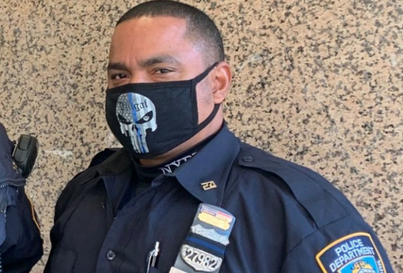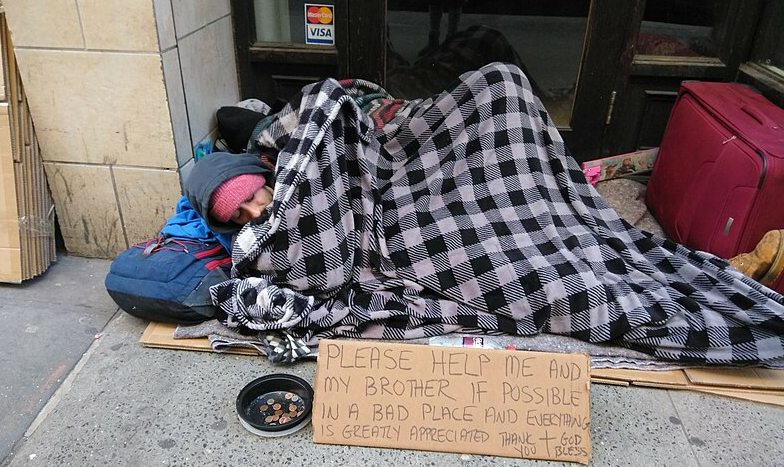Photos: Color of Change\Twitter
Above pro-Trump NYPD cop shown wearing mask with Marvel Comics character The Punisher–which is apparently liked by white nationalists, and those members of our police force who relish brutalizing civilians.
It was a little more than two years ago that I really started learning about the reality of police oversight in America. On Halloween night in 2019, my wife and our then-6-year-old daughter were walking home from trick-or-treating in our Brooklyn neighborhood when they saw a New York Police Department car go the wrong way down a street and smack into a teenager, who fell and then ran away.
When I contacted the NYPD afterward, they told me that what my family saw hadn’t happened. A police car hadn’t hit a teenager. The teenager had hit the car. Or, as an NYPD statement put it, he “ran across the hood of a stationary police car.”
I ended up diving into the case and wrote about it the next summer during the global racial justice protests spawned by George Floyd’s murder.
The police had been looking for a group of Black, male teenagers who reportedly had stolen a cellphone. After the teenager who’d been hit by the car ran away, my wife, Sara, watched as officers turned their attention to other Black boys.
The police lined the boys up against the wall of our local movie theater, then arrested three of them. The boys insisted they had just been trick-or-treating. The youngest was 12. He was crying, asking repeatedly, “What did I do?”
I didn’t hear anything more about the case for a long while. Then, a few weeks ago, the city agency charged with investigating civilians’ complaints of police abuse let me know it had finally finished its investigation.
The Civilian Complaint Review Board found that, contrary to the NYPD’s assertions, an officer did hit a kid with his car. It also found that officers, including the precinct commander, had arrested the boys without justification. An officer had even drawn his gun and pointed it at one of the boys.
One of the officers, the report noted, was wearing a sweatshirt with a logo of the Punisher, a Marvel character who kills lawbreakers, which is popular with cops and white nationalists. The sweatshirt also had a blue line over the American flag and the acronym DILLIGAF. (“Do I Look Like I Give a Fuck.”) The officer told investigators he hadn’t known the meaning of the logo or the acronym on his sweatshirt.
The police response that night started when some teenagers told officers they had been robbed at the local park. But the officers only had what investigators later described as “varying and inconsistent descriptions” of who they were looking for.
The officers stopped a group of boys a few blocks away. There was little about them that matched the description of the assailants other than that they were Black, young and walking together. Indeed, the CCRB’s report noted, one of the officers “stated that he was not certain whether they were involved.”
Some of the boys ran, including the one who was hit by the police car. (They told investigators that they ran because they were scared.)
The boys who were arrested — a 15-year-old, a 14-year-old and the 12-year-old — said that the officers never offered any explanation for why they were stopped. They were released without charges, after being held for hours. Their parents said they weren’t given any documentation on the arrests. The mother of one of the boys worked for the NYPD as a school safety officer, but even she couldn’t get any record of what happened.
It was as if the case was being pushed into a fog.
The CCRB began investigating after receiving a witness complaint. But the agency’s investigations are dependent on the NYPD cooperating. And as often happens, the NYPD has been slow to do so.
Take body-worn cameras, which are often critical in abuse investigations. The CCRB noted it faced “extremely substantial delays” in getting the Halloween night footage from the NYPD. While some cities have given civilian investigators direct access to body cam footage, the NYPD has rejected calls to do the same.
The agency also did not get to interview officers until more than a year after the incident. By the time officers did finally submit to interviews, they had serious trouble with their recollections. When the officer who drove the car was asked whether he had hit a kid, he “stated that he could not remember.”
In December, the CCRB told me it had just filed disciplinary charges against the officers: for wrongful arrests, for pulling a gun without justification, and for, as the bureaucratic lingo puts it, “Force, Vehicle.”
The next step would typically be disciplinary hearings, in which the CCRB acts as the prosecutor and the proceedings are overseen by an NYPD judge, who answers ultimately to the police commissioner. While the penalties after guilty verdicts are often wrist-slappy, like lost vacation days, it seemed like this case could be a rare, if modest, victory for police accountability.
Then, about a week after I heard about the outcome of the investigation, I learned of another twist.
The NYPD had informed the CCRB that it was invoking its authority to unilaterally end the cases against most of the officers the civilian agency had charged with misconduct. No disciplinary charges would be brought against them.
Instead of letting the CCRB’s disciplinary process play out, the NYPD said it would handle the cases internally. The NYPD wrote, as it has many times before, that allowing the CCRB case to continue “would be detrimental to the Police Department’s disciplinary process.”
When it came to the officer who had hit the kid with his car, the NYPD said it was an “alleged traffic accident” and that therefore the CCRB had no authority to investigate in the first place.
The NYPD did decide that the disciplinary charges against one officer could continue — for using offensive language and telling one of the teens to stop filming on his phone.
It was all remarkable, but also par for the course.
Like many police departments around the country, the NYPD has complete discretion to overrule the civilian agency that is supposed to help oversee it.
In New York City, the police commissioner can and often does choose to ignore the results of CCRB-brought disciplinary trials. The commissioner can ignore guilty pleas and can even decide there should be no trial at all, as appears to be happening in this case. Last year, the police commissioner followed through on the CCRB’s discipline recommendations in serious cases just 27% of the time.
I sent the NYPD a series of questions, asking both about its power to ignore the CCRB and about how that power has been wielded in this case. I got a one-sentence response: “The disciplinary process is ongoing.”
We do know something about what’s happened to the officers, and about their records. Thanks to legislation that New York state passed in the summer of 2020, police records are no longer secret. The CCRB’s report names the officers involved.
Officer Christopher Brower drove into the boy, according to the report. Officer Christopher Digioia wore the Punisher sweatshirt and is the one officer still facing a disciplinary trial, for allegedly swearing at the teens. A search of their respective CCRB files shows they were also disciplined for another case together. Investigators found that, in April 2019, about six months before the Halloween incident, the two had refused to provide their names or badge numbers to a civilian. The NYPD penalized them for that with “instructions.”
The precinct commander who the CCRB concluded oversaw the wrongful arrests is Inspector Megan O’Malley. She told investigators she believed the arrests were justified because the boys ran and one had dropped a kitchen knife. O’Malley has since been promoted and now heads a precinct in midtown Manhattan.
The officer who, the report said, first ordered the boys to be stopped and then pointed a gun at one of them is Lt. John Dasaro. He told investigators he had been worried that the boy was armed. Dasaro was moved to work at the internal affairs unit that investigates use of force against civilians.
None of the officers responded to my requests for comment.
I recently shared all the developments with one of the boys from that night. He was in ninth grade when officers ordered him up against the wall. His mom and 9-year-old sister watched from across the street, where they had been trick-or-treating.
“It’s just all getting blown over,” he said, sounding deflated. “So, it’s kind of like, what’s the point of doing all this?”
But the Halloween case isn’t fully over yet.
After the NYPD said it would be overriding the CCRB cases, the agency formally objected. The NYPD has yet to give its response.
Technically, the CCRB can move ahead if the NYPD doesn’t respond. But the reality of the current system is that any discipline or trial requires the police department to be on board.
The NYPD has a new commissioner hired by New York’s new mayor, Eric Adams, a former police officer who has often talked about his experience being beaten by officers as a teenager. Like many mayors and politicians around the country, Adams has taken something of a middle ground on policing, rejecting calls for “defunding” the force while also emphasizing that misconduct can’t be countenanced.
“Justice and public safety go together,” Adams said recently. “I don’t subscribe to the belief of some that we can only have justice and not public safety. We will have them both.”
I’ve asked Adams’ office about the Halloween case — whether the mayor thinks that there has been justice in this instance.
I have yet to hear back.
Nation of Change\By Eric Umansky\ProPublica












